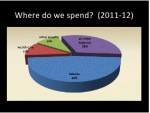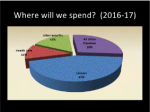By Becca Hess –
What is the state of the District? No really, what is it?
With the economy in its current state and so much news about the rising cost of public pension plans, many wonder where Penn Manor will be in the scheme of taxes, budget cuts and the future of education. Students and staff have already felt the wrath of cuts in supplies and programs but if things don’t change, or if costs take another turn for the worse, will Penn Manor be prepared and ready to take on future challenges and ensure that top priorities remain attainable?
“We are not looking to make big reductions next year. However, deficits for future years will require more consideration,” said district superintendent Mike Leichliter.
Penn Manor’s business manager Chris Johnston had a few things to say regarding the district’s budget, the same information he presented at recent State of the District meetings.
 According to Johnston, Penn Manor spent 48 percent of its 2011-2012 budget on salaries, 10 percent on health care and 10 percent on other benefits. The other 32 percent was spent on other expenses. Other expenses include transportation, mortgage, school supplies, equipment, utilities and anything else it takes to run a school.
According to Johnston, Penn Manor spent 48 percent of its 2011-2012 budget on salaries, 10 percent on health care and 10 percent on other benefits. The other 32 percent was spent on other expenses. Other expenses include transportation, mortgage, school supplies, equipment, utilities and anything else it takes to run a school.
Jump ahead a few years and the projected percentages for spending fo r 2016-2017 will change a small percentage, but there is no telling how much these small changes will affect the district and those within it. Salaries drop to 45 percent , health care is 11 percent, as other benefits will rise to 16 percent and other expenses will drop to 28 percent.
r 2016-2017 will change a small percentage, but there is no telling how much these small changes will affect the district and those within it. Salaries drop to 45 percent , health care is 11 percent, as other benefits will rise to 16 percent and other expenses will drop to 28 percent.
The proportion of money spent on particular categories is changing. It’s not that the district will be spending less money on salaries in the year 2016-2017, but that the proportion of money spent in each area will change. More money spent on pension means less money to other expenses such as school supplies. Johnston explained how this change is not just a Penn Manor problem, it’s an issue facing the entire state.
This funding gap is a big issue facing the district. It is the difference between the school’s revenue compared to what the school will pay out in expenses.

According to Johnston, the district is unable to raise revenue fast enough to keep pace with everything it has been able to afford in the past.
“We expect to have our expenses increase at a higher rate than revenue can keep up with,” said Johnston.
Johnston explained that the school board has a few options. First, they are able to raise taxes which could help offset using money in the savings account a little faster, however the amount that they’re able to increase taxes by is limited by state law. The other option, which the district has already seen, is to cut back on expenses.
Aside from the funding gap issue, there is a greater problem at hand. One that will effect the district for many years to come, said Johnston.
“The mandated increases in pension funding is the number one financial issue facing the district in the next decade,” explained Johnston. “Coupled with rising health care costs, which all businesses are facing, school districts all over the state w ill need to cut back in many areas to save money.”
ill need to cut back in many areas to save money.”
He said since most expenses are in salaries, cuts will center around retooling class offerings and the way education is delivered.
“It’s difficult to see what our schools will look like in five years,” said Johnston.
Johnston assured that the district has been discussing options to tackle this crisis for a few years now. They have included members of the community to see what input they could offer, as well as to see what mattered most to them.
“We plan to scale back in many areas rather than cutting a whole program. We realize that a well-rounded student needs a well-rounded education and our plan is to maintain choice and diversity as we move forward,” said Johnston.
Where some kids value sports and others enjoy music or the arts, Johnston explained that the district will not be cutting any one of those specific areas completely, rather they will be scaling back existing offerings, in each of those areas, in an attempt to save money.
” [We] are trying to reduce a little of everything as apposed to eliminating anything, “said Johnston.
In times of trouble such as these, it is reassuring to know that Penn Manor has seen this issue arising and has been preparing to take on the challenge.
“The district has been planning for the upcoming fiscal problems since 2003 by adding to our fund balance,” said Johnston. (He said to think of this as the district’s savings account). “The school board has been very proactive in dealing with this and has had the foresight to build our savings up to its current level (about $13 million). The good news is that we have savings to help us ease into the crisis. It won’t make the crisis go away, but it helps by giving us time to plan our steps and work out the details before we act. “
I think it’s pretty wrong to cut the music department funding by 20 percent this year and have another 25 percent scheduled to be cut for next year. All these cuts happen while other areas, such as football, has close to $100,000 to spend on whatever. The music department has tons of costs, like music and folders, along with the normal supplies for school. One copy of certain pieces of music can cost up to 25 dollars, multiply that by 90 kids and you get a whole ton of money that is needed for just music. The music department also is also much more then just a class. They are ambassadors to the school. We go out and represent Penn Manor everywhere. We have gone to Hershey Park, First Friday in the city,School Board Meetings and recently the Grand Opening of the remodeled Central Manor. No other group goes this many places under Penn Manors name. I think we deserve a little more credit then we get right now.
I didn’t even mention the Band or Orchestras needs. They need to buy instruments and music as well and I can almost guarantee that instruments are more expensive than sports equipment. One bow for a string instrument can cost over 200 dollars. That’s just one! There are 15-20 string players in the orchestra. The Marching Band needs to buy uniforms and replace old ones. They also need new instruments and new music which aren’t cheap.